Everest Base Camp Trek Frequently Asked Questions
Be well-informed and prepared for this once-in-a-lifetime journey into the heart of the majestic Himalayas.
Be well-informed and prepared for this once-in-a-lifetime journey into the heart of the majestic Himalayas.
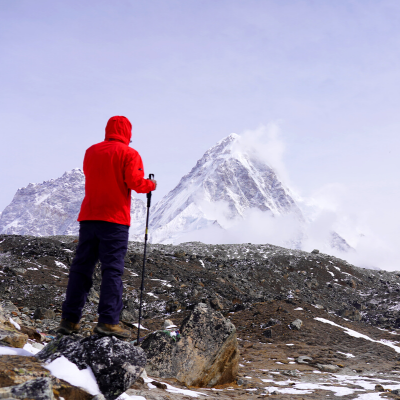

The Everest Base Camp Trek is a bucket-list adventure for many avid trekkers and outdoor enthusiasts around the world. Located in the heart of the Nepalese Himalayas, this iconic trek takes you through breathtaking landscapes, remote villages, and diverse terrains, all while offering a close-up view of the world's tallest peak, Mount Everest. The journey to Everest Base Camp (EBC) has gained immense popularity over the years, attracting thousands of trekkers each year who seek to experience the awe-inspiring beauty and the thrilling challenge of this unforgettable trek.
Given the physical demands and high-altitude conditions of the Everest Base Camp Trek, it's crucial to be well-prepared and informed about what to expect on this journey. This comprehensive FAQ blog post is designed to address the most common questions and concerns, providing you with essential information to help you plan and enjoy a safe, rewarding, and unforgettable adventure to Everest Base Camp.
Understanding the importance of preparation and knowing what to expect before embarking on the Everest Base Camp Trek is crucial for a safe, enjoyable, and successful trekking experience. The journey to Everest Base Camp is physically demanding, involves high-altitude trekking, and requires navigating through remote areas with limited resources. Proper preparation will not only enhance your experience but also minimize potential risks and difficulties along the way.
The purpose of this FAQ blog post is to provide you with accurate and reliable information on various aspects of the trek, including the best time to go, what to pack, understanding altitude sickness, and more. By addressing the most frequently asked questions, this blog aims to guide you through the planning process, helping you make well-informed decisions and adequately prepare for the challenges and rewards of the Everest Base Camp Trek.
Armed with the knowledge and insights from this FAQ blog, you'll be better equipped to face the obstacles that may arise during your journey, allowing you to focus on immersing yourself in the majestic beauty of the Himalayas and creating lifelong memories on this once-in-a-lifetime adventure.
The Everest Base Camp Trek is a challenging and awe-inspiring journey that takes trekkers through the rugged and diverse terrains of the Nepalese Himalayas to the base of Mount Everest, the world's tallest peak. The trek typically begins in Lukla and follows the Dudh Kosi river valley, crossing high suspension bridges, ascending steep trails, and passing through picturesque villages, dense forests, and glacial moraines. The trek's culmination is the arrival at the Everest Base Camp, where climbers gather and acclimatize before attempting to summit Mount Everest.

The Everest Base Camp Trek is located in the Solu-Khumbu region of Nepal, which is home to the stunning Sagarmatha National Park, a UNESCO World Heritage site. The base camp itself lies at an altitude of 5,364 meters (17,598 feet) on the south side of Mount Everest. The trek holds significant importance for adventure-seekers and mountaineers, as it provides an up-close view of the world's highest peak and offers a rare opportunity to experience the unique culture of the Sherpa people who inhabit the region.
The Everest Base Camp Trek has its roots in the early 20th-century expeditions to Mount Everest, with the first successful ascent by Sir Edmund Hillary and Tenzing Norgay in 1953. Since then, the trek has gained immense popularity among adventure enthusiasts and mountaineers worldwide. Each year, thousands of trekkers make the journey to the base camp, drawn by the allure of Everest's majestic beauty, the challenge of high-altitude trekking, and the chance to immerse themselves in the rich culture and stunning landscapes of the Himalayas.
Related Article: Everest Base Camp Trek in Nepal
Get in touch with our experts right away and finalize an experience!
About UsThe best time to trek to Everest Base Camp typically falls within two primary seasons: pre-monsoon (spring) and post-monsoon (autumn). The spring season lasts from March to May, while the autumn season runs from late September to early December. During these periods, the weather is generally stable, offering clear skies, moderate temperatures, and favorable conditions for trekking.
Spring (March-May):
Pros:
- Warmer daytime temperatures
- Beautiful rhododendron and other wildflower blooms
- Exciting atmosphere with climbers preparing to summit Everest
Cons:
- Potential for more crowded trails and accommodations
- Possibility of afternoon clouds obstructing mountain views
Autumn (September-December):
Pros:
- Clearer skies and better visibility of mountains
- Cooler daytime temperatures, which can be more comfortable for trekking
- Less crowded trails and accommodations compared to the spring season
Cons:
- Colder nighttime temperatures
- Chance of early snowfall in late November and December

When deciding on the best time for your Everest Base Camp Trek, consider the following factors:
Weather and trail conditions: Both spring and autumn offer stable weather, but autumn generally has clearer skies, while spring can be warmer and more vibrant with blooming flowers.
Crowds: If you prefer fewer crowds, autumn might be a better choice. However, spring offers a lively atmosphere with many climbers and trekkers on the trail.
Personal fitness and experience: If you're less experienced or concerned about your fitness level, you might find the slightly warmer temperatures during the spring season more accommodating.
Time and flexibility: Choose the season that best aligns with your schedule and personal preferences. Just remember that the monsoon season (June to September) is best avoided due to heavy rainfall, slippery trails, and poor visibility.
Ultimately, the best time for your trek will depend on your personal preferences and priorities, so weigh these factors carefully before making a decision.
Related Article: Best Time to Visit Everest Base Camp Trek
The average duration of the Everest Base Camp Trek is 12-14 days, including acclimatization days to adjust to the high altitude. The total distance of the trek varies depending on the specific route taken, but the round-trip distance from Lukla to Everest Base Camp and back is approximately 130 kilometers (80 miles).
Several factors can affect the duration of your trek, including:
Acclimatization: To minimize the risk of altitude sickness, it's essential to follow a proper acclimatization schedule with rest days at specific altitudes. This can add extra days to your trek.
Fitness level: Your physical fitness can impact the pace at which you cover daily distances, which may affect the overall duration of your trek.
Trekking route: Different routes to Everest Base Camp can vary in length and difficulty, which can influence the time required to complete the trek.
Weather conditions: Unfavorable weather conditions, such as heavy snowfall or rain, may require additional days for safety and trail accessibility.

There are several trekking routes to reach Everest Base Camp, each with varying durations and levels of difficulty. Some popular routes include:
Classic Everest Base Camp Trek: This is the most popular route, starting from Lukla and passing through Namche Bazaar, Tengboche, and Lobuche before reaching the base camp. The round-trip duration is typically 12-14 days.
Gokyo Lakes and Everest Base Camp Trek: This route diverges from the classic route at Namche Bazaar, leading trekkers through the stunning Gokyo Lakes and over the challenging Cho La pass before rejoining the main trail to the base camp. This trek usually takes 16-18 days to complete.
Jiri to Everest Base Camp Trek: This longer and less-traveled route starts in Jiri, retracing the original footsteps of Sir Edmund Hillary and Tenzing Norgay. The trek involves additional days of walking before reaching Lukla and joining the main trail. This trek takes around 20-22 days to complete.
When choosing a route, consider factors such as your fitness level, available time, and personal preferences to ensure a rewarding and enjoyable experience.
Related Article: Everest Base Camp Trek Elevation
The Everest Base Camp Trek is considered a moderately challenging trek, suitable for individuals with a reasonable level of fitness and some prior trekking experience. While the trek does not involve technical climbing, it demands stamina and endurance to navigate the often steep and rugged trails at high altitudes.
Several factors contribute to the difficulty of the Everest Base Camp Trek, including:
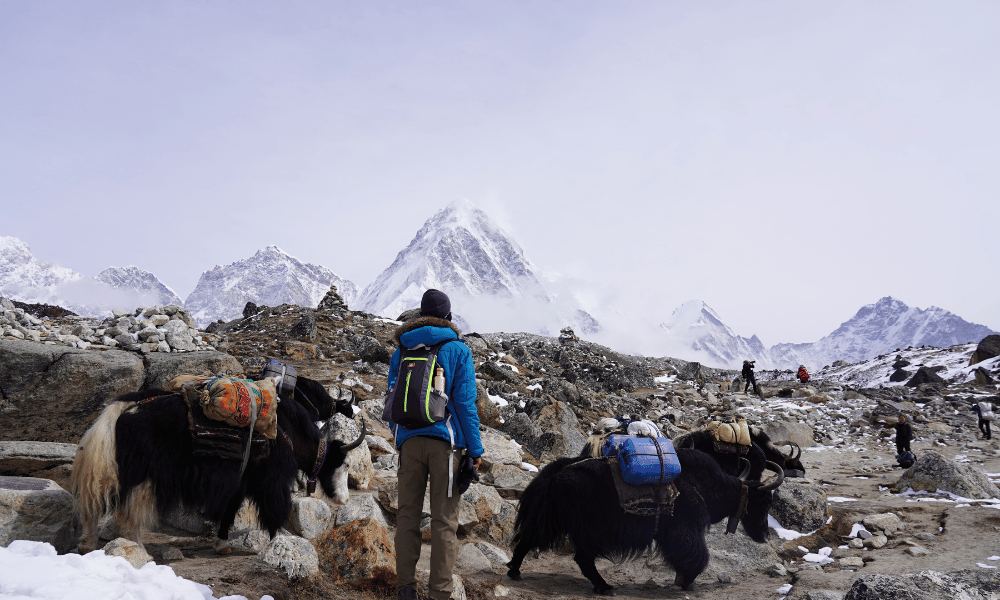
Altitude: The trek involves significant altitude gain, reaching over 5,300 meters (17,000 feet) at the base camp. The thin air at high altitude can make physical exertion more challenging and increase the risk of altitude sickness.
Terrain: The trek includes steep inclines, rocky trails, and high suspension bridges that demand physical stamina and mental resilience.
Weather: Weather conditions in the Himalayas can change rapidly, and trekkers may face cold temperatures, strong winds, and occasional snowfall, which can add to the challenge of the trek.
Duration: The trek's duration of 12-14 days, with daily walks of 5-8 hours, requires sustained endurance and stamina.
To better manage the challenges of the Everest Base Camp Trek and enhance your experience, consider the following tips:
Prepare physically: Engage in regular cardio exercises, strength training, and endurance-building activities (such as hiking) in the months leading up to your trek to improve your fitness level.
Acclimatize properly: Follow a well-planned acclimatization schedule with rest days to help your body adjust to the high altitude and minimize the risk of altitude sickness.
Pace yourself: Walk at a comfortable pace and take regular breaks to avoid overexertion, particularly as you gain altitude.
Stay hydrated and nourished: Drink plenty of water and eat balanced meals throughout the trek to maintain energy levels and support your body's adaptation to altitude.
Hire a guide or join a group tour: A knowledgeable guide or organized tour can provide valuable support, local insights, and safety measures, enhancing your overall trekking experience.
Be mentally prepared: Expect some degree of physical and mental challenge during the trek and maintain a positive attitude to help overcome obstacles along the way.
By taking these tips into account, you'll be better equipped to handle the difficulties of the Everest Base Camp Trek and enjoy a more rewarding and memorable experience.
Related Article: How Difficult is Everest Base Camp Trek
To embark on the Everest Base Camp Trek, you will need the following permits:
Sagarmatha National Park Entry Permit: This permit is required to enter the national park, which encompasses the majority of the trekking route.
Khumbu Pasang Lhamu Rural Municipality Entrance Permit (formerly known as the TIMS card): This permit is required for all trekkers entering the Khumbu region.
Sagarmatha National Park Entry Permit: This permit can be obtained either at the Nepal Tourism Board office in Kathmandu or at the park's entrance gate in Monjo. The permit application requires your passport details and two passport-sized photos.
Khumbu Pasang Lhamu Rural Municipality Entrance Permit: This permit can be obtained at the Nepal Tourism Board office in Kathmandu or at the entrance checkpoint in Lukla. You will need to provide your passport details and two passport-sized photos for this permit as well.
The costs for the necessary permits are as follows:
Sagarmatha National Park Entry Permit: NPR 3,000 (approximately USD 30) per person for foreign nationals, excluding the value-added tax (VAT).
Khumbu Pasang Lhamu Rural Municipality Entrance Permit: NPR 2,000 (approximately USD 20) per person for foreign nationals.
Please note that permit costs are subject to change, so it's essential to verify the most up-to-date information before your trek. Also, keep in mind that if you join an organized tour or hire a trekking agency, they can help you obtain the required permits, and the costs are usually included in the overall package price.
Related Article: Everest Base Camp Trek Permits
When packing for the Everest Base Camp Trek, consider the following clothing and gear recommendations:
Layered clothing: Bring lightweight base layers, insulating mid-layers (fleece or down), and waterproof, breathable outer layers (jacket and pants) to accommodate fluctuating temperatures and weather conditions.
Trekking boots: Choose comfortable, well-fitting, and broken-in trekking boots with good ankle support and grip for navigating the varied terrain.
Socks: Pack several pairs of moisture-wicking, quick-drying socks designed for trekking.
Gloves: Bring lightweight gloves for lower altitudes and insulated, waterproof gloves for higher elevations and colder temperatures.
Headwear: Pack a sun hat or cap, a warm beanie, and a buff or neck gaiter to protect your head and neck from the sun, wind, and cold.
Sunglasses: Select sunglasses with UV protection and side shields to protect your eyes from the sun and glare.
Backpack: Choose a comfortable, well-fitting backpack (40-60 liters) with adjustable straps and a rain cover to protect your belongings.
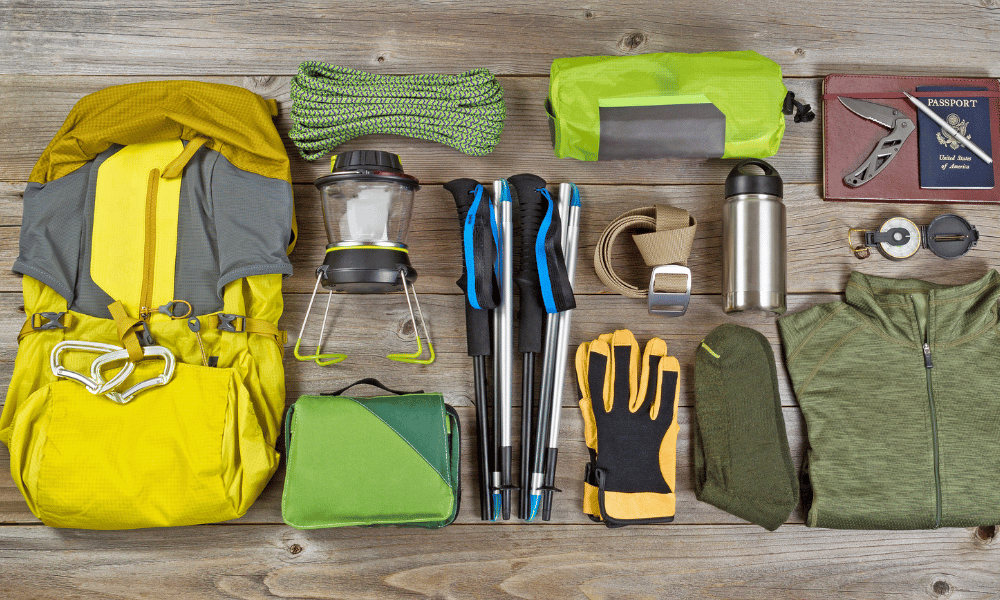
In addition to appropriate clothing and gear, consider packing the following essential items for your trek:
Water bottle or hydration system: Bring a reusable water bottle or hydration bladder with a capacity of at least 1 liter to stay hydrated throughout the trek.
Snacks: Pack high-energy, non-perishable snacks such as energy bars, trail mix, and dried fruit to fuel your trek.
First aid kit: Carry a basic first aid kit with items such as band-aids, painkillers, blister treatment, and any personal medications you require.
Sunscreen and lip balm: Bring high-SPF sunscreen and lip balm to protect your skin and lips from sun exposure and windburn.
Headlamp or flashlight: Pack a headlamp or flashlight with spare batteries for early morning starts and navigating in the dark.
Trekking poles: Consider using trekking poles for added support and stability, particularly during steep descents.
Camera and portable charger: Bring a camera or smartphone to capture the stunning scenery, and a portable charger to keep your devices powered.
To pack efficiently and effectively for the Everest Base Camp Trek, follow these tips:
Pack light: Limit your pack's weight by only bringing essential items, as you will be carrying it for several days at high altitude.
Use packing cubes or compression bags: Organize your clothing and gear in packing cubes or compression bags to save space and keep your belongings tidy.
Distribute weight evenly: Balance the weight in your backpack by placing heavier items in the middle and lighter items on top and bottom. This will improve your stability and comfort while trekking.
Waterproof your gear: Use waterproof bags or ziplock bags to protect essential items, such as electronics and important documents, from moisture.
Test your gear: Before embarking on the trek, test all of your gear and wear new items, such as trekking boots, to ensure comfort and functionality.
By following these packing recommendations and tips, you will be well-prepared for the challenges and varying conditions of the Everest Base Camp Trek.
Related Article: Everest Base Camp Trek Packing List Suggestions
Accommodations along the Everest Base Camp Trek primarily consist of teahouses, which are small, family-run lodges that provide basic rooms and meals for trekkers. Teahouses typically offer twin-sharing rooms with simple beds, mattresses, and blankets. While they may not have all the luxuries of a hotel, they provide a warm, hospitable atmosphere where you can interact with fellow trekkers and experience local culture. Some teahouses also have dormitory-style rooms available. In lower altitude villages, such as Lukla and Namche Bazaar, there are guesthouses and lodges with slightly more amenities and comfort.
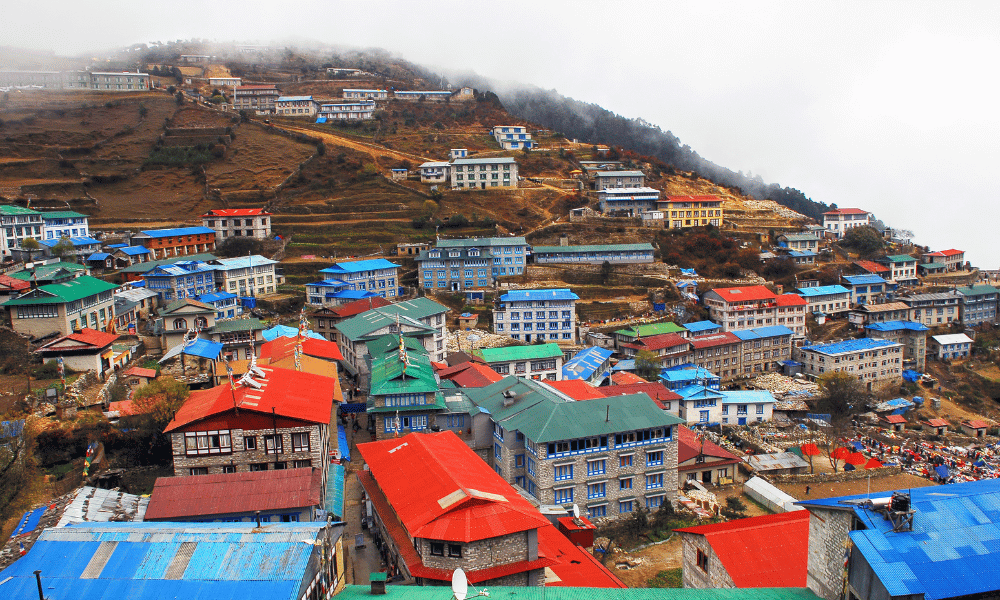
Teahouse accommodations generally do not require advance bookings, except during peak trekking seasons when it's advisable to secure a room ahead of time. If you are trekking with a guide or as part of an organized tour, your guide or tour operator will typically arrange accommodations for you.
The cost of a teahouse stay varies depending on the altitude, location, and available facilities, but on average, you can expect to pay around USD 5-15 per night for a basic room. Keep in mind that these prices can increase during peak seasons. Meals and beverages at teahouses are usually charged separately and can range from USD 2-5 for simple dishes like dal bhat (rice and lentils) to USD 5-10 for items like pasta or pizza.
To select the best accommodation for your needs during the Everest Base Camp Trek, consider the following tips:
By considering these tips, you can choose the lodging option that best suits your needs and preferences, ensuring a comfortable and enjoyable trekking experience.
Related Article: Everest Base Camp Trek Accommodation
Teahouses along the Everest Base Camp Trek serve a range of meals to accommodate various tastes and preferences. The menu typically includes local Nepali cuisine, as well as popular international dishes like pasta, pizza, and sandwiches. Breakfast options often include porridge, eggs, toast, and pancakes, while lunch and dinner feature soups, noodles, rice, and potato dishes. Vegetarian options are widely available, and most teahouses can cater to specific dietary restrictions upon request.
While trekking to Everest Base Camp, be sure to try some of these popular local dishes:
To stay hydrated and healthy during the Everest Base Camp Trek, consider the following tips:
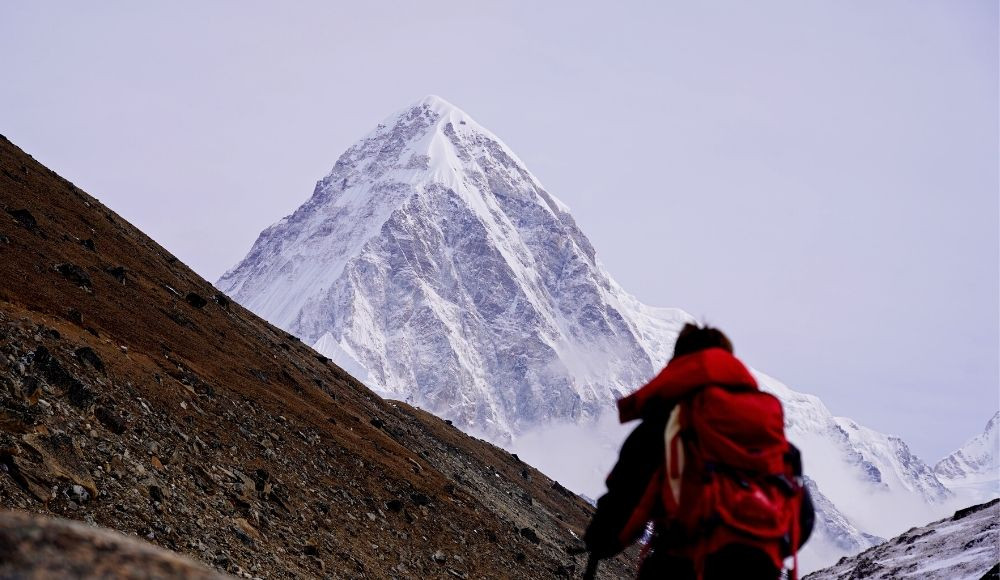
By following these tips, you can maintain proper hydration and nutrition levels, helping to ensure a more enjoyable and successful trekking experience.
Related Article: Nepalese Food
Altitude sickness, also known as Acute Mountain Sickness (AMS), is a common concern for trekkers on the Everest Base Camp Trek due to the significant altitude gain. It occurs when the body fails to acclimatize properly to the reduced air pressure and lower oxygen levels at higher elevations. Altitude sickness can affect anyone, regardless of age, fitness level, or prior experience at altitude.
Symptoms of altitude sickness can range from mild to severe and typically begin to appear at elevations above 2,500 meters (8,200 feet). Common symptoms include:
If left untreated or if a person continues to ascend despite experiencing symptoms, altitude sickness can progress to more severe forms, such as High Altitude Pulmonary Edema (HAPE) or High Altitude Cerebral Edema (HACE), which can be life-threatening.
To prevent and manage altitude sickness during the Everest Base Camp Trek, follow these tips:
By following these guidelines, you can minimize your risk of altitude sickness and enjoy a safer and more comfortable trekking experience.
Related Article: Altitude Sickness in Nepal
Hiring a local guide or joining a group tour can greatly enhance your safety and overall trekking experience. Guides have extensive knowledge of the route, weather, and local culture, and can help you navigate potential challenges such as altitude sickness or unexpected changes in trail conditions. They can also assist with arranging accommodations and permits, ensuring a smooth and hassle-free journey. Participating in a group tour can provide additional support and camaraderie, as well as the opportunity to share the experience with like-minded trekkers.
To promote responsible trekking and minimize your impact on the environment and local communities, keep the following considerations in mind:
To ensure a safe and healthy trekking experience, consider the following tips:
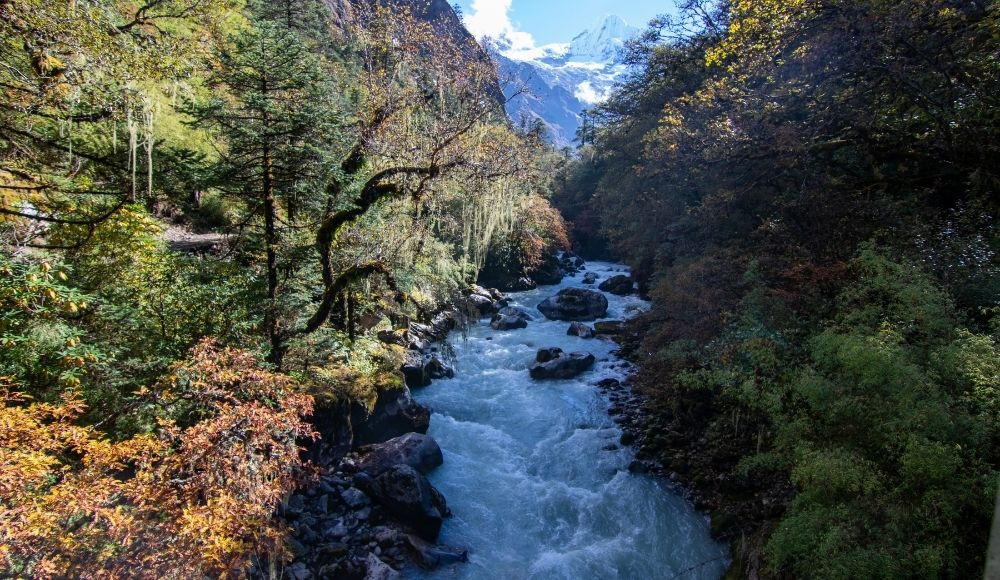
By following these guidelines, you can enjoy a safe, responsible, and fulfilling trekking experience while minimizing your impact on the environment and local communities.
The Everest Base Camp Trek is an unforgettable adventure that takes you through breathtaking landscapes, diverse cultures, and into the heart of the majestic Himalayas. Being well-informed about various aspects of the trek, such as the best time to go, what to pack, how to prevent altitude sickness, and how to ensure a safe and responsible trekking experience, is crucial to maximizing your enjoyment and success on this challenging journey.
With the right preparation, knowledge, and respect for the environment and local communities, you are well-equipped to embark on the adventure of a lifetime and create memories that will last forever. The trek to Everest Base Camp is not just about reaching your destination, but also about discovering your strength, resilience, and appreciation for the beauty of our natural world.
We encourage you to share your questions, experiences, or advice in the comments section below. Your insights and stories can help others prepare for their own trek to Everest Base Camp and contribute to a supportive and informative community of adventure-seekers.
Now it's your turn to take the first step towards experiencing the magic and wonder of the Everest Base Camp Trek!